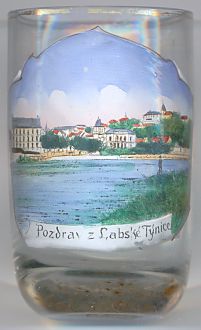

|
| ČESKÁ REPUBLIKA | CZECH REPUBLIC |
| Středočeský kraj | Central Bohemia region |
| Okres: Kolín |
 Týnec nad Labem (pervious German name: Elbeteinitz) is situated at an elevation of 243 m on the river Labe
(Elbe) in the east of the Kolín district of Central Bohemia. The municipality has a
population of a bout 2,000 (2017).
Týnec nad Labem (pervious German name: Elbeteinitz) is situated at an elevation of 243 m on the river Labe
(Elbe) in the east of the Kolín district of Central Bohemia. The municipality has a
population of a bout 2,000 (2017).
At this place the river Labe had created a gorge through the last foothills of the Železné hory (Iron Mountains) and thus provided a well-protected place for a settlement. Týnec was mentioned in the Chronica Boëmorum of Cosmas of Prague as the place where two members of the Přemyslide dynasty, Duke Vladislav I of Bohemia and Otto of Olomouc, met for a dispute in 1110. In the 14th century Týnec became part of the possessions of the Cistercian monastery of Sedlec (today part of Kutná Hora). After the Hussite Wars, during which the Sedlec monastery was destroyed, Týnec had many owners, the most prominent being Vilém of Pernštejn. In the list of his possessions, the town is listed as Taynecz. In 1560 Týnec was purchased by Archduke Maximilian of Austria, the later Emperor Maximilian II. In 1600 Emperor Rudolf II granted Týnec the status of a town of the Royal Chamber which went with important further privileges for the town.
The  church of the Beheading of St. John [background top right]
was built in the second half of the 18th century.
church of the Beheading of St. John [background top right]
was built in the second half of the 18th century.
According to popular belief, Týnec nad Labem is the place where in 1830 Anna Slezáková invented the Polka dance.
[https://de.wikipedia.org/wiki/Týnec_nad_Labem;
http://www.tynecnadlabem.cz/default/page?pageSpace=6&archive=1&pageId=52;
http://deacademic.com/dic.nsf/dewiki/1119861/Polka;
https://de.wikipedia.org/wiki/Týnec]
![[scale]](lineal.jpg)